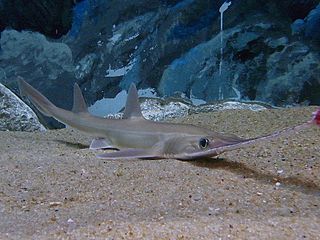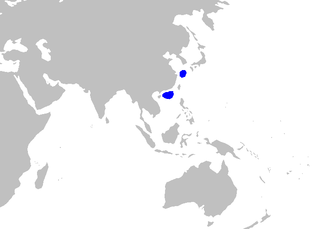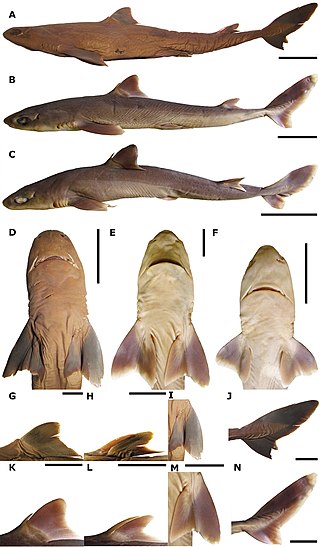
The spiny dogfish, spurdog, mud shark, or piked dogfish is one of the best known species of the Squalidae (dogfish) family of sharks, which is part of the Squaliformes order.
Squalus is a genus of dogfish sharks in the family Squalidae. Commonly known as spurdogs, these sharks are characterized by smooth dorsal fin spines, teeth in upper and lower jaws similar in size, caudal peduncle with lateral keels; upper precaudal pit usually present, and caudal fin without subterminal notch. In spurdogs, the hyomandibula is oriented at a right angle to the neurocranium, while in other sharks, the hyomandibula runs more parallel to the body. This led some to think that the upper jaw of Squalus would not be as protractile as the jaws of other sharks. However, a study that compared different jaw suspension types in sharks showed that this is not the case and that Squalus is quite capable of protruding its upper jaw during feeding.

The bignose shark is a species of requiem shark, in the family Carcharhinidae. Distributed worldwide in tropical and subtropical waters, this migratory shark frequents deep waters around the edges of the continental shelf. It is typically found at depths of 90–430 m (300–1,410 ft), though at night it may move towards the surface or into shallower water. The bignose shark is plain-colored and grows to at least 2.7–2.8 m (8.9–9.2 ft) in length. It has a long, broad snout with prominent nasal skin flaps, and tall, triangular upper teeth. Its pectoral fins are long and almost straight, and there is a ridge on its back between the two dorsal fins.

The Japanese sawshark is a species of sawshark in the family Pristiophoridae. This shark has a long, narrow rostrum. Its first dorsal fin originates behind the tips of the pectoral fins, and its caudal fin is angled almost straight in line with the body. The Japanese sawshark reaches a maximum length of up to 1.36 m.

The blotchy swellshark or Japanese swellshark is a common species of catshark, belonging to the family Scyliorhinidae. The Blotchy swellshark is found at depths of 90–200 m (300–660 ft) in the northwestern Pacific Ocean, from Japan to Taiwan. It is benthic in nature and favors rocky reefs. Reaching 1.4 m (4.6 ft) in length, this thick-bodied shark has a broad head, large mouth, and two unequally-sized dorsal fins positioned far back past the pelvic fins. It can be identified by its dorsal coloration, consisting of seven brown "saddles" and extensive darker mottling on a light tan background. This species has often been confounded with the draughtsboard shark and the Sarawak pygmy swellshark in scientific literature.

The Japanese roughshark is a rare species of shark in the family Oxynotidae, known only from a handful of specimens recovered from Suruga Bay and the Enshunada Sea off Japan. It is a benthic species that occurs at a depth of 150–350 m (490–1,150 ft). This shark is caught as bycatch by bottom trawlers throughout its entire limited range, and may be threatened given the declines in other bottom deep sea species in Suruga Bay.

The shortspine spurdog is a dogfish, a member of the family Squalidae, found on continental shelves off Japan in temperate waters, from the surface to 950 m. Its length is up to 75 cm.

The spotless smooth-hound is a species of houndshark, in the family Triakidae, found on the continental shelves of the northwest Pacific, between latitudes 40° N and 11° N, from the surface to a depth of 300 m. It can grow to a length of up to 1 m.

The blackgill catshark is a deep water catshark known from very few specimens, found on or near the bottom on the continental slope, at 540–835 metres (1,772–2,740 ft) off the coasts of China and Japan. Specimens can attain a total length of at least 85 cm (33 in), have elongated cat-like eyes, and have two small dorsal fins set far back. They’re oviparous and lay one egg at a time. This shark is a potential bycatch of deep water bottom-trawl fisheries operating within its range, but no specific information is available. In the upper jaw, there are rods of blunt, flat teeth with 3 cusps, likely used for crushing, as well as row of sharper teeth with the mid, central cusp longer and to a point. The bottom teeth are sharp, pointed, jagged and have three cusps, with the middle cusp slightly longer than the surrounding two.

The blackspotted catshark is a catshark of the family Scyliorhinidae. It is found in the waters off the coasts of Japan, Korea, China, and Taiwan between latitudes 39° N and 20° N, at the depths of between 80 and 100 m. It can grow up to 49 cm in length.

The gecko catshark is a species of catshark, part of the family Scyliorhinidae, native to the northwestern Pacific Ocean from southern Japan to Taiwan, and possibly also off Vietnam. It is a common, demersal species found at depths of 100–900 m (330–2,950 ft). Its body is slender, with a pattern of dark saddles and blotches. The dorsal and caudal fins are edged in white, and there is a prominent crest of enlarged dermal denticles along the dorsal edge of the caudal fin. The gecko catshark is a schooling, opportunistic predator of bony fishes, cephalopods, and crustaceans. It is oviparous, with females producing two vase-shaped egg capsules at a time. This species is captured as bycatch, but does not appear to be threatened by fishery activities at present and has been assessed as Least Concern by the International Union for Conservation of Nature (IUCN).

The shortnose demon catshark is a catshark of the family Scyliorhinidae found only in deep water in the East China Sea. Its length is up to 40 cm. A. internatus is known only from the holotype and a paratype, both caught in the East China Sea, probably taken as bycatch in deepwater trawl fisheries. The reproduction of this catshark is oviparous.

The Taiwan angelshark is an angelshark in the family Squatinidae. The Taiwan angelshark is one of four species of Squatina in the waters around Taiwan and Japan. It is a demersal, ray-like shark that grows to 1–2 meters in length.

The Japanese angelshark is a species of angelshark, family Squatinidae, found in the northwestern Pacific Ocean off China, Japan, and Korea. It is a bottom-dwelling shark found in sandy habitats down to 300 m (980 ft) deep. This species has the flattened shape with wing-like pectoral and pelvic fins typical of its family, and grows to 1.5 m (4.9 ft) or more in length. Its two dorsal fins are placed behind the pelvic fins, and a row of large thorns occurs along its dorsal midline. Its upper surface is cryptically patterned, with numerous squarish dark spots on a brown background.
The Yantai stingray, is a little-known species of stingray in the family Dasyatidae, inhabiting shallow waters in the northwestern Pacific Ocean off the coasts of China and Japan. Measuring no more than 20–30 cm (7.9–11.8 in) across, this species is characterized by its diamond-shaped pectoral fin disc wider than long, completely smooth skin, dorsal coloration of dark irregular spots on a yellowish gray-brown background, and ventral coloration of more spots on a white background with yellowish margins. One of the three most common stingrays sold for food in China, the slow-reproducing Yantai stingray faces possible overfishing and habitat degradation, and its numbers appear to be declining. The International Union for Conservation of Nature (IUCN) has assessed it as vulnerable.

The Japanese sleeper ray is a species of electric ray in the family Narkidae. It is common in the inshore and offshore waters of the northwestern Pacific Ocean from southern Japan to southern China. Growing up to 40 cm (16 in) long, the Japanese sleeper ray has a nearly circular pectoral fin disc colored reddish to chocolate brown above, sometimes with darker or lighter spots, and lighter brown below. The spiracles behind its small eyes have raised, smooth rims. Its short and muscular tail bears a single dorsal fin positioned aft of the rounded pelvic fins, and terminates in a large caudal fin.

The bighead spurdog is a rare and little-known species of dogfish shark in the family Squalidae. It is found in deep water south of New Caledonia, and over the Norfolk Ridge. Reaching at least 90 cm (35 in) in length, this stocky shark is brown above and light below, with a broad head and two dorsal fins with long spines. It is the only member of its genus with both one- and three-pointed dermal denticles. An infrequent bycatch of longline fisheries, this species is listed under Data Deficient by the International Union for Conservation of Nature (IUCN).
Squalus montalbani, the Philippine spurdog or Indonesian greeneye spurdog, is a relatively large species of dogfish shark native to waters off the coast of Australia, the Philippines, and Indonesia. The species was identified in 1912 from a specimen caught off the coast of Luzon Island, and has been both bycatch and a targeted species in fisheries since. Its taxonomy is complex, having been renamed in 1931, being misidentified as a type of shortspine spurdog, then being revived as a species in 2007.

The Japanese shortnose spurdog is a dogfish shark in the genus Squalus. It is found from southern Japan to the South China Sea. The length of the longest specimen measured is 60 cm (24 in).
The greeneye spurdog is a species of dogfish described in 2007. It is a member of the family Squalidae, found off the coast of southeastern Australia. The length of the longest specimen measured is 85.6 cm (33.7 in). It was considered conspecific with the shortspine spurdog.



















